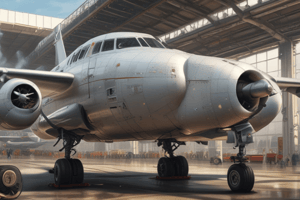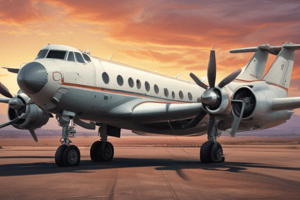Podcast
Questions and Answers
What is the primary purpose of the information provided in the notes?
What is the primary purpose of the information provided in the notes?
- To provide study and training guidance only (correct)
- To substitute for the Aircraft Maintenance Manual
- To ensure compliance with legal requirements
- To serve as a comprehensive reference for ongoing maintenance
Which knowledge level is indicated for applicants who are familiar with basic elements of a subject?
Which knowledge level is indicated for applicants who are familiar with basic elements of a subject?
- Knowledge Level 2
- Knowledge Level 1 (correct)
- Knowledge Level 4
- Knowledge Level 3
What must be consulted when carrying out procedures on aircraft or aircraft equipment?
What must be consulted when carrying out procedures on aircraft or aircraft equipment?
- General aviation regulations
- The latest safety guidelines from the FAA
- Common industry best practices
- The relevant Aircraft Maintenance Manual or manufacturer's handbook (correct)
Which categories must meet the basic knowledge levels defined for category C applicants?
Which categories must meet the basic knowledge levels defined for category C applicants?
What is the primary instruction regarding the reproduction of this publication?
What is the primary instruction regarding the reproduction of this publication?
What is required for an applicant at Level 2 regarding theoretical fundamentals?
What is required for an applicant at Level 2 regarding theoretical fundamentals?
Which of the following best describes the objectives for an applicant at Level 3?
Which of the following best describes the objectives for an applicant at Level 3?
What is NOT an objective for an applicant at Level 2 concerning mathematical formulae?
What is NOT an objective for an applicant at Level 2 concerning mathematical formulae?
Which of the following tasks would NOT be expected from a Level 3 applicant?
Which of the following tasks would NOT be expected from a Level 3 applicant?
How does the ability to read and understand schematics differ between Level 2 and Level 3?
How does the ability to read and understand schematics differ between Level 2 and Level 3?
Flashcards are hidden until you start studying
Study Notes
Training Foreword
- Information is for study/training purposes only; no revision service is provided.
- Always reference relevant aircraft maintenance manuals or equipment manufacturer handbooks when performing procedures.
- Follow health and safety regulations from manufacturers, companies, national safety authorities, and governments.
Copyright Information
- All rights reserved; reproduction without written permission from Thakur Institute of Aviation Technology is prohibited.
Aircraft Maintenance Licence Knowledge Levels
- Categories include A, B1, B2, B3, and C for Aircraft Maintenance Licence, with Level indicators reflecting basic knowledge requirements.
Knowledge Level Indicators
- Level 1: Familiarization with subject elements; ability to describe using common terms and give basic examples.
- Level 2: General knowledge; ability to apply theoretical fundamentals, read and understand drawings, and use mathematical formulae.
- Level 3: Detailed knowledge; ability to integrate different subjects, read and prepare technical drawings, and apply practical knowledge using manufacturer's instructions.
Understanding Waves
- Waves can be classified into mechanical and electromagnetic.
- Mechanical waves require a medium, produced by a disturbance (e.g., sound or water waves).
- Key behavior of waves includes energy transport without matter movement.
Wave Types
- Transverse Waves: Oscillate at right angles to wave direction; observable in ripples when an object is dropped in water.
- Longitudinal Waves: Particle motion occurs in the same direction as wave travel; characterized by compressions and rarefactions.
Key Wave Concepts
- Compression: Region where particles in a longitudinal wave are closest together.
- Rarefaction: Region where particles are furthest apart in a longitudinal wave.
Wave Interference
- Superposition principle allows for the summation of various waves to form a new wave.
- Destructive Interference: Occurs when two waves of opposite displacements meet, reducing overall amplitude (e.g., noise-cancellation technology).
Practical Applications
- Understanding wave behavior is crucial for engineering, particularly in designing systems that leverage wave properties for noise control and energy transmission.
Studying That Suits You
Use AI to generate personalized quizzes and flashcards to suit your learning preferences.




